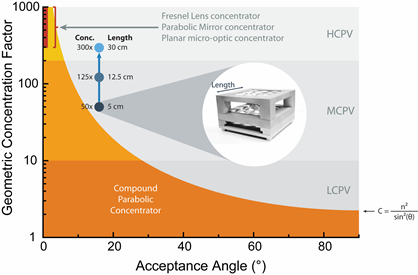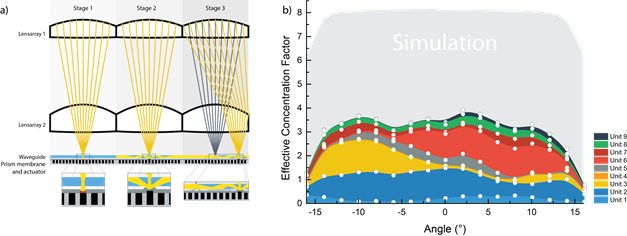Self-Tracking Solar Concentrator System
In concentration photovoltaics (CPV) solar cells are reduced in size, thus saving on expensive semi-conductor PV cell material. The receiving aperture is replaced by a focusing optical system, forming the concentrator, which can be either of the imaging, non-imaging type or a combination thereof. The intensity of sunlight on earth is around 1000 W/m² (on an average sunny day) and the optical power received is directly proportional to the area of the entrance element of the optical system. The reduction in solar cell material however, comes at the expense of a tracking need in order to keep the focal spot on the now reduced solar cell.

Figure 1. There is a trade-off between concentration factor and acceptance angle. For any given acceptance angle, there is an upper limit of possible concentration (orange area, n=1.5). Due to this the field of CPV technologies is divided into three categories: High, medium, and low CPV. Our approach has a concentration factor that is to the right of the curve, due to its self-tracking mechanism, capable of reaching 300x geometric concentration with ±16° acceptance angle (dark spot).
State of the art concentrators need precise mechanical tracking with tolerances below 1° in two directions to track for diurnal and seasonal changes of the sun’s position. The required tracker adds additional cost to the system, diminishing the savings from a smaller solar cell. In addition it consumes energy, decreasing the overall system efficiency, and requires constant maintenance, further increasing the costs. The class of self-tracking concentrators uses a part of the solar spectrum to power an internal, self-aligning mechanism and by this track the sun’s position. These concentrators have the potential to track seasonal variations and increase the tolerances of the tracking requirement, which translates into cheaper, less precise tracking.

Figure 2. (a) The lens arrays used in the demonstration device were created from one inch off-the-shelf lenses by milling the outer parts and leaving the center square. (b) The pair of lens arrays use a custom holder to keep them at the desired separation. Simulations and experiments show a possible acceptance angle of ±16°.
Work done at LAPD focuses on the development of a light-responsive mechanism based on phase-change materials to develop such a self-tracking concentrator. Current research has led to the construction of a working demonstration device with an angular acceptance angle of 32° (±16°) and a measured 3.5x effective concentration (compared to 7x by simulation). By further increasing the size of the device and optimize the optical system, effective concentrations of 200x with an acceptance angle of 46° (±23°) are achievable.

Figure 3. (a) The three stages show the actuation and the self-tracking mechanism. In stage 1, the dichroic mirror splits the spectrum in two parts. The transmitted part (red; >750 nm) is transmitted and absorbed by the paraffin wax (black). In stage 2, the paraffin wax melts and expands upward, creating a coupling feature for the reflected light (yellow). As the sun moves throughout the day/season the focal spot changes and a different part of the actuator is activated (stage 3).
(b) The summed measurement results of the nine units result in an effective concentration of 3.5x over the angular range of ±16°. This is only about a factor of 2 smaller than the one predicted by simulations (grey area) and is mostly due to the units not performing perfectly over the entire angular range.
Publications:
Articles:
Contact: Volker Zagolla.